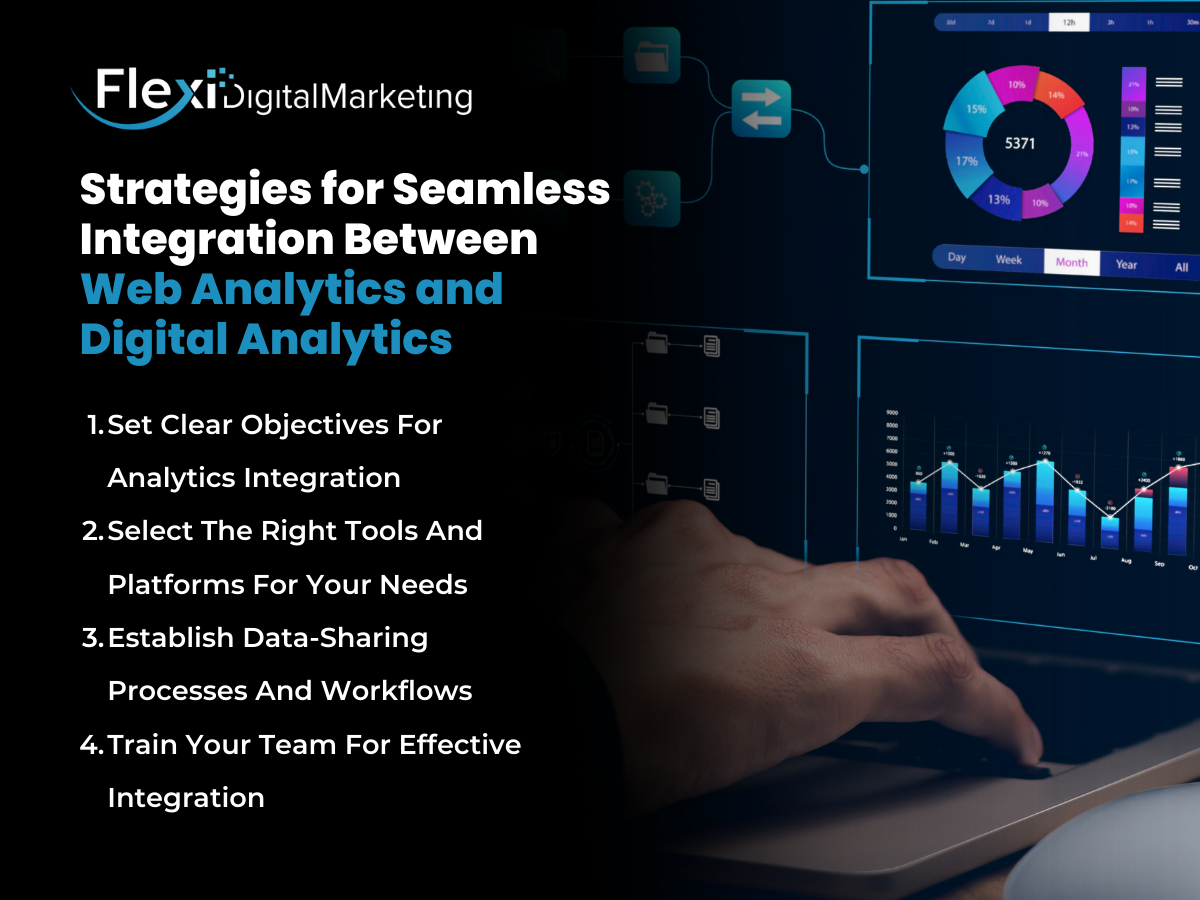Are you drowning in website clicks and ad impressions? While your digital marketing efforts send in eager crowds and you track their every move, the question still remains: Are you getting the results that you want to see?
If your answer is no, then you are in the right place. We are sharing how you can seamlessly weave web analytics and digital analytics into a potent growth cocktail.
In this article, we are stepping away from siloed data pools and we are grabbing our mixing bowls. Here, we will explore the intricacies of online presence optimisation to help you create your potent formula for these two tools to click and see substantial growth.
Web Analytics and Digital Analytics: What is the Difference?
Before we plunge headfirst into the potent potion of blended analytics, let us clear a few things first.
A lot of people mix up the terms web analytics and digital analytics, treating them like interchangeable ingredients in our growth recipe. But here is the thing: They are different from one another.
With that in mind, understanding their differences is key to concocting the perfectly blended web and digital analytics strategy to achieve sustainable growth. In addition, we want to underline the importance of analytics in digital marketing in this article and its vital role in helping you navigate the highly competitive landscape of marketing.
What is Web Analytics?
If you boil it down, it is essentially a means to observe every click, scroll, and bounce with laser focus. It tells you who visited, what pages they explored, and how long they stayed.
It is kind of like “the marauders’ map” from Harry Potter. It is a detailed map of your online terrain, highlighting traffic patterns, engagement hotspots, and potential conversion canyons.
Why is Web Analytics Important?
Web analytics answers the "what" and "how" of your website.
It shows you how users navigate your digital domain, revealing pain points, hidden gems, and opportunities for optimisation. With this, you can tailor your website to be a frictionless journey, guiding your visitors from casual browsers to loyal customers.
Web analytics answer questions like:
- Who is visiting?
- Where are they coming from?
- What devices are they using?
- How long are they staying?
- What pages are they viewing?
- What are they clicking on?
- Are they taking the actions you want (like buying or subscribing)?
- Which paths lead to conversions?
What is Digital Analytics?
It reveals the bigger picture beyond what you would immediately notice.
If web analytics is like a magnifying glass, then digital analytics are binoculars.
It enables you to zoom out, showing you the entire scheme of things such as the paths you laid out (marketing channels), the “bait” you crafted (campaigns), and the ultimate destination (conversions).
More importantly, it answers the crucial question: What brought them here in the first place?
Why is Digital Analytics Important?
It is not just about counting guests (clicks) or admiring the engagements. Digital marketing also needs to understand the entire guest experience to either lean into that or improve upon it.
Plus, digital analytics answer questions like:
- Which of your campaigns are driving the most traffic and conversions?
- What is the ROI of each campaign?
- How are users interacting with your brand across different touchpoints (website, social media, email)?
- Which channels deserve credit for a conversion?
- How can you optimise your marketing mix for maximum impact?
If you combine them: Web analytics paints a vivid picture of your website's performance, but it does not tell the whole story. That is where digital marketing analytics and insights step in. It shines a spotlight on the "why" behind the clicks and conversions.
Benefits of Integrating Web Analytics and Digital Analytics
Separately, these two share valuable insights. But, blending them together is where the magic happens, transforming your digital marketing campaigns into a harmonious and resonating experience that turns them into loyal customers.
So, why is integrating web and digital analytics so crucial for online success? Let us explore the benefits of integrating web analytics and digital analytics.
Reveal the Customer Journey
Web analytics tells you how visitors navigate your website. On the other hand, digital analytics reveals the path that led them there.
Together, they paint a holistic picture of the customer journey, showing you where they encounter your brand, what resonates with them, and where they might get lost in the shuffle.
Optimise for Conversions
With that in mind, web analytics shines a light on these conversion roadblocks, like high bounce rates or confusing checkout processes. Digital analytics shows you which marketing channels are delivering the most promising diners. This allows you to optimise your campaigns and entice your audience with targeted offers and personalised experiences.
Boost Return on Investment (ROI)
By integrating web and digital analytics, you can track your ROI for each campaign, identifying the high-performing dishes and sending the less-popular ones back to the kitchen for a rework. This data-driven approach ensures you are investing in strategies that truly drive growth for your business.
Personalise Digital Interactions
Customers crave unique experiences tailored to their preferences.
So, by understanding their behaviour through web analytics and their journey through digital analytics, you can craft personalised interactions at every touchpoint. Imagine serving up relevant content recommendations and targeted offers that cater to individual tastes.
Refine the Digital Experience
Integrating web and digital analytics empowers you to experiment, testing different marketing ingredients and measuring their impact in real-time. The data tells you all, enabling you to continuously refine your digital marketing efforts and serve up experiences that keep your audience coming back for more.
Strategies for Seamless Integration Between Web Analytics and Digital Analytics
But before we throw them into the blender, here is something to keep in mind: Seamless integration is not just about tossing some numbers together.
Your focus is on creating a symphonic harmony of data analysis strategies, where insights from your website seamlessly dance with the rhythm of your marketing campaigns.

Set Clear Objectives For Analytics Integration
Web analytics and digital analytics are powerful tools, but they are not magic gadgets that you can just wave around. Their effectiveness hinges on knowing exactly what you want to achieve. So, you need to define your goals—this will be your North Star, guiding you into how you will blend these two.
Ask yourself this: Why do you want to integrate web and digital analytics?
Is it to understand how your Facebook ads translate into website conversions? Maybe you just want to identify content that ignites leads and fuels the customer journey. Either way, you need to be concrete and clear with your goal—so, write them down.
Select The Right Tools And Platforms For Your Needs
Now that you have mapped your analytical journey with clear objectives in hand. It is time to grab your trusty tools and build a robust digital marketing analytics framework.
But, here is the thing: Not all tools are created equal and only a few can handle a digital analytics cocktail. So, choosing the right tools and platforms is vital, this spells the difference between a masterpiece and a burnt offering.
With that said, you can start your search here:
- Web Analytics Platforms
- Digital Marketing Platforms
- Data Integration Tools
- Digital Campaign Analysis Platforms
Establish Data-Sharing Processes And Workflows
Before you start tossing things together, you need to ensure your workflow runs like clockwork. That is where data-sharing processes and workflows step in.
For this step, you need to set up a couple of things.
- Data Tagging and Tracking - Ensure your website and marketing platforms speak the same language, sending accurate data signals across the divide.
- Standardised Data Definitions - Establish consistent definitions across all your tools, eliminating any possibility of miscommunication.
- Scheduled Data Refreshes - Define your refresh schedules to keep your insights fresh and relevant to your marketing decisions.
- Create Seamless Data Flows - Set up automated data flows between your platforms, ensuring a smooth and continuous stream of insights.
- Define Roles and Responsibilities - Establish clear roles and responsibilities for your data team to ensure everyone knows their part.
Train Your Team For Effective Integration
Last, but not least, you need a savvy team trained in data interpretation and action. This is because they serve as the bridge between raw data and actionable insights.
Your potent data analytics strategy would flop if your team does not know how to maximise it to its full potential.
Here is how you approach this:
- Break down the jargon and explain key metrics, like creating a digital marketing analytics syllabus, to make sure they are fluent in the language of data and be able to dissect reports with confidence.
- Provide hands-on training on your chosen tools, equipping your team with the practical skills to navigate the interfaces and extract valuable insights.
- Train your team to analyse reports, identify trends, and translate data into actionable recommendations that inform marketing strategies and optimise campaigns.
- Cultivate a culture of data-driven decision-making, where insights are valued, shared, and used to continuously improve your online efforts.
Tools and Platforms for Integration
With that in mind, you need the right platforms and tools to create a potent data analytics cocktail. We listed below some of the best and battle-tested instruments to achieve seamless integration.
Analytics Powerhouses
- Google Analytics - This is a free web analytics tool that offers comprehensive website insights, traffic analysis, and conversion tracking. It is perfect for beginners and budget-conscious businesses but it might lack advanced features for larger organisations.
- Adobe Analytics - This is a premium player that boasts robust customisation options, sophisticated attribution models, and deep integrations with other Adobe marketing tools. It is ideal for data-hungry enterprises seeking granular control and actionable insights.
- Kissmetrics - This is a more customer-centric option that, focuses on user behaviour analysis, funnel optimisation, and personalised engagement strategies. It is great for businesses looking to understand their audience on a deeper level and nurture leads effectively.
Digital Marketing Mashups
- HubSpot Marketing Hub - This is an all-in-one marketing suite that seamlessly integrates website analytics with email marketing, social media management, and CRM functionalities. If you are a small or medium business, this is a perfect fit if you are seeking a unified platform for your marketing efforts.
- Marketo Engage - This is a powerful enterprise-grade marketing automation platform that offers sophisticated campaign management, lead scoring, and predictive analytics. This is an ideal option if you have a large organisation with complex marketing needs and multi-channel campaigns.
- Mailchimp - On the other hand, this is a beginner-friendly email marketing platform with built-in website analytics and audience segmentation capabilities. This is a great choice if you are a solopreneur or a small business owner starting out with email marketing and want basic web insights.
Integration Wizards
- Fivetran - This is an ETL (Extract, Transform, Load) tool that automates data transfer between your web and digital marketing platforms, ensuring seamless data flow and eliminating manual data entry.
- Segment - This is a customer data platform (CDP) that unifies data from all your marketing channels to create a single customer view and enable you to personalise marketing experiences.
- Google Data Studio - This is a free reporting and visualisation tool that allows you to combine data from different sources, including web and digital analytics platforms, into actionable reports.
Conclusion
Remember, web analytics and digital analytics are not rivals, rather they are complementary ingredients. By blending them with a dash of creativity and a heaping spoonful of data-driven insights, you can concoct a digital marketing strategy that fuels your business growth.
That is why it is essential to recognise the synergy between web analytics and digital marketing strategies. When you apply digital and website analytics to your digital marketing efforts, you can gain deeper insights into user behaviour, identify high-performing channels, and enhance the overall customer experience.
Are you ready to unlock the potential of your online presence and supercharge your growth? Dive into the world of analytics integration with us and reap the rewards. Contact us now!


